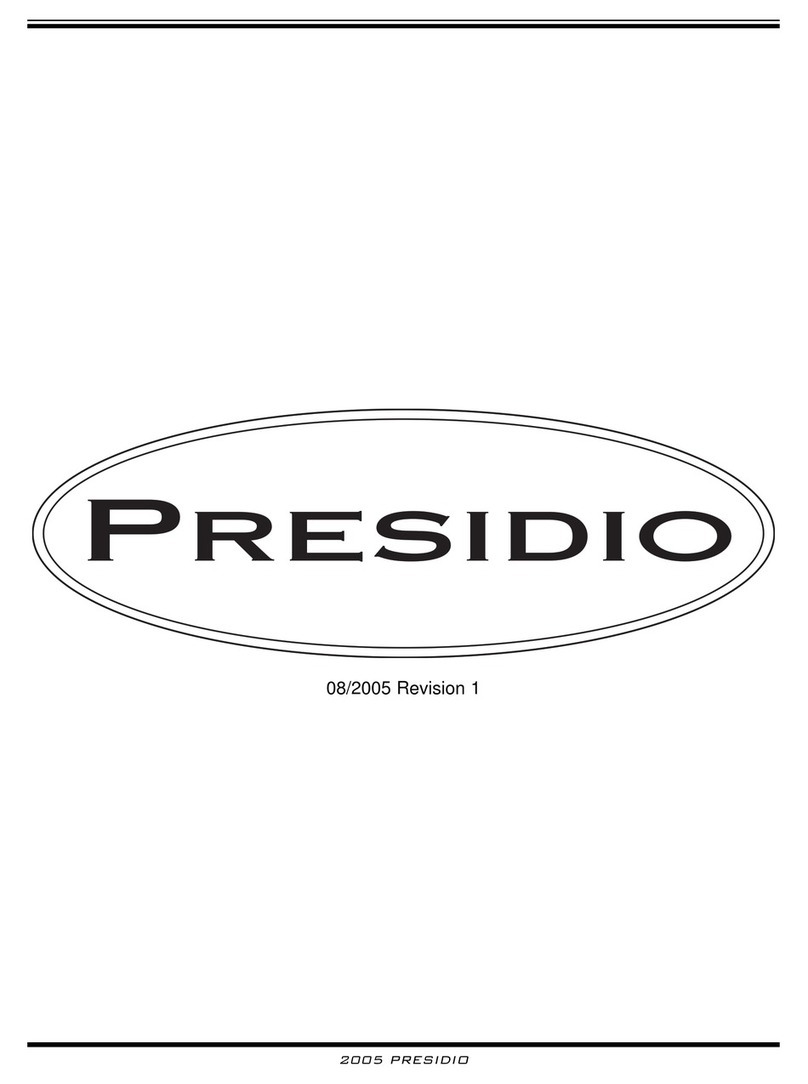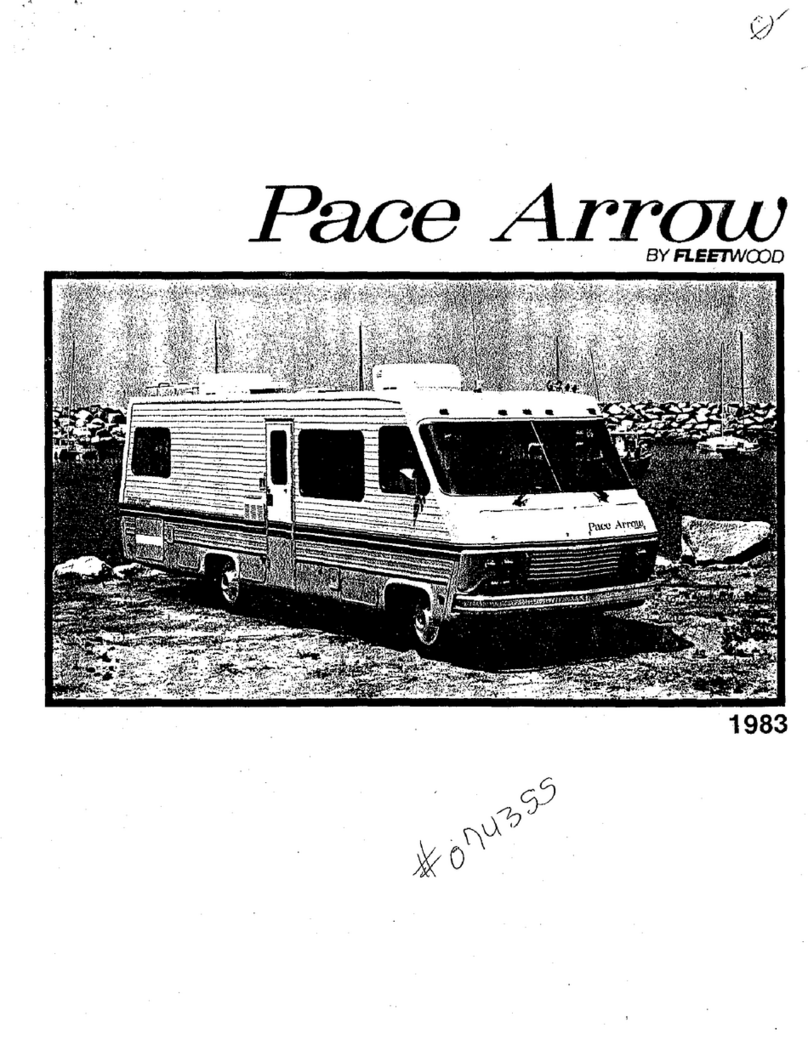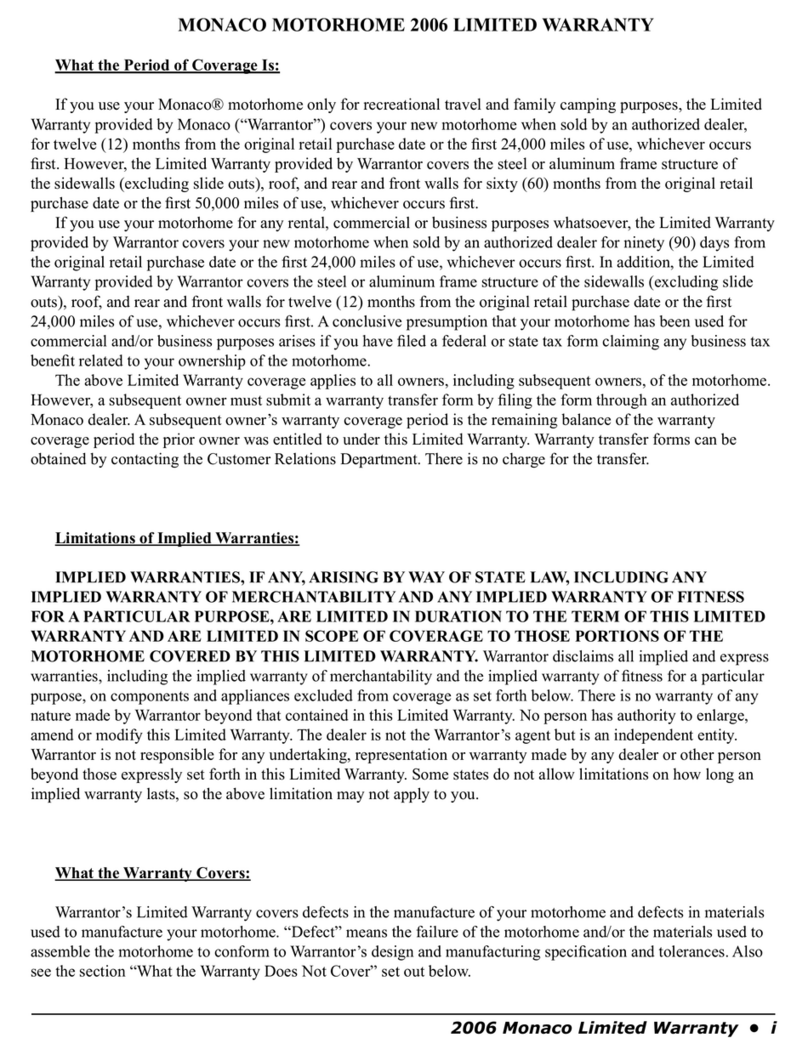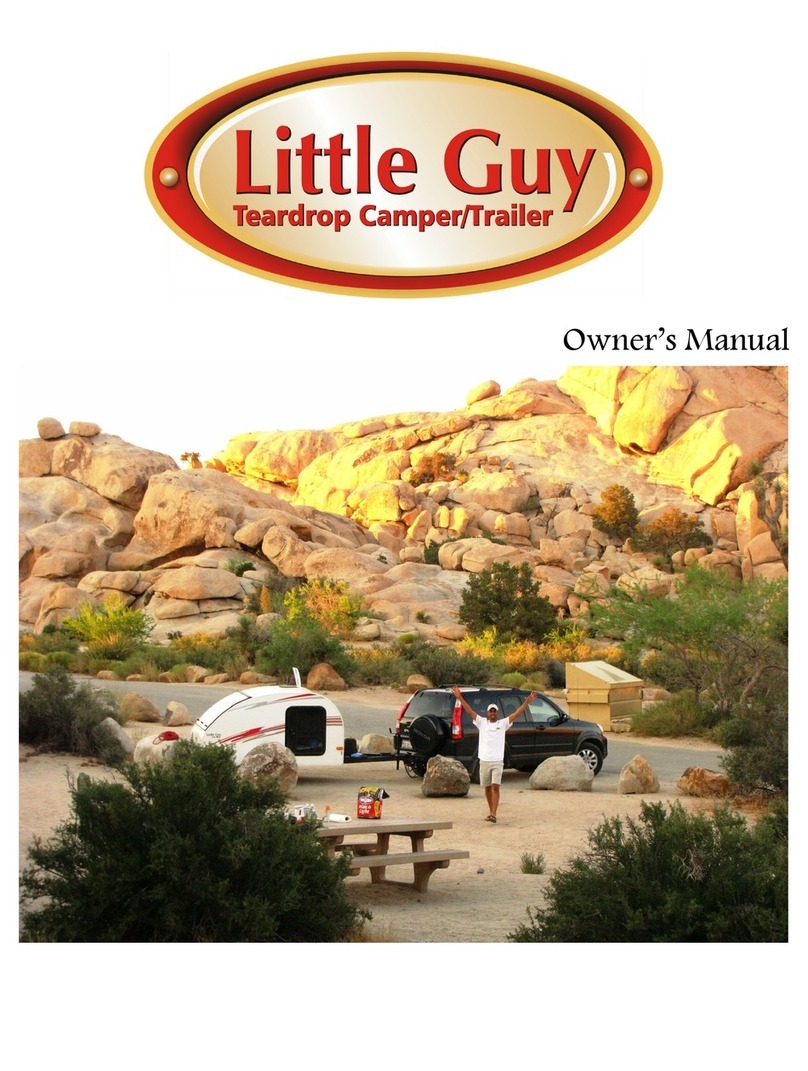New Horizons SUMMIT User manual

OWNERS MANUAL

Congratulations on your choice of a New Horizon’s recreational vehicle (RV).
This guide has been prepared to be of assistance to New Horizon’s owners in the
care, maintenance, and operation of their RV.
When planning a trip to another state, we suggest that you check ahead for
information detailing the laws for the state of your destination. Some states have
specific laws pertaining to recreational vehicles.
Familiarization with the living aspects of the RV should begin with locating each
appliance and system and understanding its PROPER AND SAFE operation. We
strongly urge owners to be sure that each family member or traveling companion,
who use any of these items of equipment, be instructed in their proper use. Each
appliance and system have its own manual which is in the Owner Information
Package in your New Horizons RV. Be sure to read each manual and complete and
submit each component regulation card or register the component’s online
warranty per the manufacturer’s guidelines.
After reading this manual, be sure to keep it in your RV as a reference. New
Horizons RV Corp. will be happy to provide any further information you feel you
need, as well as answer any questions about operating the equipment in your RV.
Maintaining your New Horizons in top operating condition will ensure a long life
for your RV. Accordingly, we suggest that you pay particular attention to the
maintenance sections of this manual.
On behalf of the manufacturer, New Horizons RV Corp. of Junction City, Kansas,
we are proud to have you as a New Horizons owner. Please be assured that your
comments and suggestions are welcome.
NEW HORIZONS RV CORP. RESERVES THE RIGHT TO CHANGE
MATERIALS, STANDARD FLOOR PLANS AND/OR SPECIFICATIONS
AT ANY TIME WITHOUT WRITTEN NOTICE OR OBLIGATION. REVISED MATERIAL CAN BE OBTAINED
THROUGH NEW HORIZONS RV CORP. 1-800-235-3140
Revised 10/2019

DELIVERY
Manufacturer Responsibilities
A pre-delivery inspection and systems check. Thoroughly inspecting the RV and
the operation of the factory installed components.
A customer walk-through. This is done to familiarize the customer with the RV, its
systems and components, and their operations.
Delivery of the Owner’s Information Package. The detailed operating and
maintenance instructions on these components are also included in this manual.
Providing the customer with information regarding warranty and non-warranty
work on the RV and its separately warranted components whether the customer is
in or out of the area.
Customer Responsibilities
The customer is responsible for regular and proper maintenance of the RV.
Properly maintaining your RV will prevent conditions arising from neglect that
will not be covered by the manufacturer’s warranty. The maintenance guidelines in
this manual and any other applicable manual should be followed. It is your
responsibility and obligation to return the RV to a reputable dealer or the factory
for repairs and service.
To assist you in avoiding problems with your RV, we recommend you do the
following:
Read the warranty. Fill out and mail all warranty cards promptly.
Inspect the RV.
Ask questions about anything you do not understand concerning your RV.
Enjoy your New Horizons RV. Travel safe and have fun.
IMPORTANT:
Fill out the component registration forms and mail within the prescribed
time to avoid loss of warranty coverage.

New Horizons RV Two Year Limited Warranty
New Horizons RV. Corp. (hereinafter referred to New Horizons). expressly
warrants this recreational vehicle to the original purchaser, to be free from defects
of materials or faulty workmanship for a period of two years (730 days) from date
of original retail purchase (unit completion), or until the day the original purchaser
sells or transfers their interest in the Product to a subsequent owner. This Product is
warranted for nor-mal use, which includes recreational, temporary, or full-time
living.
This warranty expressly includes the structural portion of this recreational vehicle
and provides a guarantee against defects of materials or faulty workmanship of the
steel frame, wood / aluminum structure, laminated sidewalls, roof, and all other
parts and assemblies manufactured in whole or in part by New Horizons.
This warranty does not cover
Equipment and appliances such as tires, brakes, axles, water heater, water pump,
furnace, stove, power jacks, generator, refrigerator, microwave, air conditioner,
electronic equipment, power converter, step, etc. which are warranted directly by
their respective manufacturers and are subject to their warranty terms and
conditions. New Horizons provides copies of these written warranties to the owner
at the time of the retail sale.
Damage to or related to:
Environmental condition (salt, hail, chemicals in the atmosphere)
Failure to do normal maintenance such as check all exterior sealants twice per year
for cracks and/or voids which will allow water infiltration
Alteration or modification to the unit
Accident, negligence, or misuse of the unit
Normal wear and tear & exposure, carpet wear, fabric fading on furniture, etc.
Tire balancing and wheel alignment
Service items: light bulbs, fuses, lubricants, etc.
Condensation on or around windows
Any unit used for commercial purposes, rental, or leased. Commercial means used
for business for prof-it or income purposes at any time.

Damage Limitations
New Horizons will not be responsible for incidental or consequential damages
including but not limited to loss of use of vehicle, loss of income, loss of time,
inconvenience, expense of travel, lodging, transportation and/or towing charges, or
loss or damage to personal property. Some states do not allow the exclusion of
limitation of incidental or consequential damages. In those states, the above
limitation on damages may not apply.
Oral and implied Limitations:
NO ORAL OR IMPLIED WARRANTIES EXIST EXCEPT THOSE SPECIFICALLY EXPRESSED HEREIN, IN
FACT OR IN LAW, (INCLUDING ANY WARRANTY OF MERCHANTABILITY OR FITNESS FOR A
PARTICULAR PURPOSE). Some states do not allow limitations on implied warranties,
so, the above limitation of implied warranty may not apply to you.
THIS WARRANTY MAY NOT BE AMENDED AND IS NOT TRANSFERABLE OR ASSIGNABLE.
Owner's Obligation
Written notice of the defects must be given to New Horizons within 30 days after
the defect has been discovered by the retail purchaser. Notice must be received by
New Horizons during the warranty period. If repairs are needed, they will be made
without charge, excluding any freight, after the Product is taken to New Horizons.
The owner is responsible for normal maintenance. However, minor adjustments,
such as door catches, baggage doors, LP regulators, slide room adjustments, etc.
will be made by New Horizons within 90 days of delivery, thereafter, these
adjustments are the responsibility of the owner as normal maintenance unless
required as a direct result of repair or replacement of a defective part under this
warranty. The owner will contact New Horizons with enough information to
resolve the problem. The owner shall be responsible for transportation costs to
New Horizons. In the event it is deemed by New Horizons the factory is beyond a
reasonable distance, New Horizons may, at its discretion authorize a third-party
dealership to perform warranty work.

If New Horizons deems this case to be true:
-Owner must notify New Horizons IN ADVANCE of all warranty work
-Requested Repair Shop must have an RVIA certified RV technician on staff
-New Horizons must contact the repair shop prior to any work being started
for consultation of the most efficient path to resolution
-All warranty work must be pre-approved by New Horizons
-All other associated costs such as transportation, loss of use, etc. are
applicable as described above
Since the third-party dealership is not a franchised New Horizons RV. Corp., they
may choose not to allow payment directly from New Horizons, in which case the
owner would be required to pay the dealership directly. New Horizons then would
reimburse the owner within (30) days of receipt of proper documentation.
Legal Rights:
This warranty gives you the specific legal rights and you may also have other
rights, including but not limited to those provided by the Magnuson-Moss
Warranty Act, 15U.S.C. 2301 et seq. as well as other rights, which may vary from
state to state.

Minus Ten (-10) Degree Guarantee
New Horizons guarantees our fifth wheels and travel trailers from freezing the
holding tanks, water tank, water lines, and other essential plumbing down to
MINUS TEN (-10) degrees Fahrenheit, (-23 Celsius) or -10-degree wind chill. For
this guarantee to be applicable, the unit must have dual-pane windows installed and
the furnace must be in operation. This “MINUS TEN DEGREE GUARANTEE” is
in effect on models titled 2017 and newer only. It runs and expires concurrently
with your normal warranty period. (This guarantee excludes exterior water lines,
washer lines, ice maker lines, and exterior shower).
If the water system in your New Horizons unit should freeze, unit must be returned
to the factory subject to terms and conditions explained above, and New Horizons
will resolve the issue in the area that froze. New Horizons may, at its discretion,
contact the National Weather Service to provide data on the weather conditions for
that time period in the area you were located.
COMPONENT WARRANTY SUMMARY
New Horizons warrants this recreational vehicle to the original purchaser, to be
free from defects of materials or faulty workmanship for a period of two years
from date of retail purchase. Component parts purchased by New Horizons are
covered under separate manufacturers' warranty specific to the item.
This information is based on how your coach is equipped with “standard” features. Optional equipment
added to your coach that replaces standard items may carry different warranties. For warranty
information on optional equipment, please refer to the user’s manual supplied with the optional item(s).
The above information is subject to change without prior notice. Brands and options may vary on a
specific unit due to availability, and/or substitutions. Please consult with New Horizons for additional
information.

SAFETY PRECAUTIONS
WARNING
Prior to towing your RV, be sure you have read this entire owner’s guide and that you
understand your RV’s equipment completely and how to use the equipment safely. Read and
understand all instructions and precautions in this manual before operating your new RV. Listed
below are some safety precautions that must be adhered to.
(Items 1-3 see state regulations on passengers riding in fifth wheels or travel
trailers: some states do not allow this).
1. DO NOT ride in vehicle while it is in motion.
2. Use care when accelerating or down shifting on a slippery surface. Abrupt speed
changes can cause skidding and loss of control.
3. Do not alter the LP gas system at any time or in any way.
4. Never use an open flame to test for LP gas leaks. Replace all protective covers
and caps on LP system after filling.
5. Never use the range or oven for comfort heating as it will deplete the interior
oxygen and produce deadly carbon monoxide. While cooking, make certain a
window or other ventilating means is open to the outside.
6. Never allow your LP tank to be filled above the 80 percent level.
7. If you have any leakage or failure, whatsoever, in your LP gas system,
immediately turnoff the gas at the tank or bottle, and contact your dealer or an
authorized LP gas mechanic or service facility.
8. All pilot lights and appliances must be turned off while refilling the fuel or LP
tank.
9. Never load the fifth wheel in excess of the gross vehicle weight rating (GVWR)
or the gross axle weight rating (GAWR) for either axle.
10. Do not mix different construction types of tires on your RV such as radial, bias,
or belted tires as vehicle handling may be affected.

11. Do not use portable fuel burning equipment, including wood and charcoal grills
and stoves, inside the recreational vehicle. The use of this equipment inside the RV
may cause fires or asphyxiation.
12. The LP tanks must be turned “OFF” prior to moving your RV and while
traveling.
13. The tires on your RV must be of the proper size and properly inflated for the
load which you are carrying.
14. Check tire pressures and tightness of wheel lug nuts before and during travel.
15. Never carry extra gasoline inside the fifth wheel or travel trailer.
16. Never plug your external power cord into a non-grounded outlet unless an
adapter with a grounding pigtail is used to connect the external ground.
17. Always unplug your external power cord should you ever receive an electric
shock, however slight. Locate the cause before reconnecting power.
18. Check correct operation of all exterior lights.
19. Check to see that all doors and exterior access panels are securely fastened
before traveling.
20. The fire extinguisher should be inspected monthly for proper charge and
operating condition. The smoke alarm should also be tested on a regular basis. The
label on the detector should be removed when preparing the unit for the first trip.
In addition to the recommended inspection, these should also be checked prior to a
vacation or extended trip.
21. Become familiar with the operation of the escape windows but use these
windows strictly as an emergency exit.

CUSTOMER RELATIONS
To schedule an appointment for maintenance or service work at the factory:
WRITE:
New Horizons RV Corp
2401 Lacy Drive
Junction City, Kansas 66441
CALL:
TF: 1-800-235-3140
P: (785) 238-7575
FAX: (785) 238-4992
EMAIL:
ken@horizonsrv.com
info@horizonsrv.com
Thank you for allowing New Horizons to build your dream!
Wishing you great adventures & happy trails!

TABLE OF CONTENTS
Section 1
Exterior & Interior Care………………………………………………………...1
Section 2
Electrical Systems………………………………………………………………7
Section 3
LP Gas System…………………………………………………………..........17
Section 4
Major Appliances……………………………………………………………..32
Section 5
Environmental………………………………………………………………...37
Section 6
Potable Water…………………………………………………………………43
Section 7
Wastewater……………………………………………………………………51
Section 8
Entertainment…………………………………………………………………56
Section 9
Hitching/Leveling…………………………………………………………….58
Section 10
Checklists/Pre-Travel/Travel………………………………………………….65
Section 11
Fire Safety/Emergency Checklist……………………………………………..71
Helpful Tools………………………………………………………………....72

SECTION ONE

1
EXTERIOR CARE
Washing
The exterior of your new recreational vehicle is made of pre-finished fiberglass.
Frequent washings and thorough cleanings are required to prevent damage to the
vehicle finish after exposure due to damaging salts, calcium chloride, road tar, tree
sap, insects, and other foreign material. Damage caused by exposure to these items
is not covered by your warranty agreement. Never wash the vehicle in direct
sunlight, while the vehicle is hot, or with hot water. Buildup of mud and dirt under
the body can cause damaging rust on steel parts. Corrosive materials, such as those
used for ice and snow removal and dust control, also accumulate on the underside
of the vehicle. These materials should be removed by flushing the underbelly
regularly with water, especially areas where mud and other foreign materials
collect. The chance of corrosion can be minimized by frequent washings of the
vehicle. When washing the vehicle, do not use strong soaps or detergents. Always
use a mild soap in warm water, or a commercially prepared product used
specifically for the care of fiberglass coaches, available at camping stores. Also,
your local car wash is a good choice, but be careful when using a pressure-type
washer to avoid loosening any exterior decals or sealants, etc. After washing,
carefully inspect the caulking around window frames and vents and any other
joints that may have separated. Re-caulking, if necessary, is relatively simple and
is considered routine maintenance which is the responsibility of the owner.
IMPORTANT
Never use a strong solvent, such as lacquer thinner, or harsh abrasives,
on any of the exterior painted surfaces.
Waxing
The exterior finish will require a routine waxing. When water will not bead and
roll off a freshly washed RV, a new coat of wax is needed. Wax not only improves
the appearance of the vehicle, but it also protects the finish against oxidation and
corrosive materials. The recommended type is one that is compatible with painted
or gel-coated fiberglass finishes and contains a UV (ultra-violet) inhibitor. Buffing
with a polishing compound will improve a dull or discolored finish.
IMPORTANT
When using a polishing compound that does not contain a wax preservative, reapplying a coat
of hard wax after polishing is recommended.

2
Seals
The seals around doors, windows, vents, slide out trim and external seams should
also be checked at least twice per year. Also check caulking around the roof vents
to be sure that it is pliable and intact.
Roof
XTRM PLY is easy to clean and maintain. Follow the steps below to help keep
your XTRM PLY Roofing System looking brand new.
1. From the side of the RV, wet the surface of the roof membrane with clean, soapy
water, sponged or sprayed on.
2. Scrub or brush the soapy water thoroughly to loosen any built-up dirt or
sediment.
3. Rinse the soapy water from the surface with clean water. A rubber squeegee
may be used to direct the water off the roof.
Recommended Cleaners
: Fantastik, Soft Scrub, Windex, Tilex, Murphy’s Oil Soap
DO NOT USE:
Cleaning Solutions Containing Solvents, Abrasive Pads
IMPORTANT
Use caution when working on top of your RV.
The roof may be slippery when wet.
Striping and Decals
The striping and decals on your RV require little maintenance. Treat these as you
would any painted surface on your RV. Wash them with mild soap and warm
water, or any retail car soap. Never wash the vehicle in direct sunlight, while the
vehicle is hot or with hot water. Rinse thoroughly to prevent soap residue
accumulation. Use caution with high-pressure wash nozzles. Keep them at least
eighteen (18) inches from the edge of the decals. High-pressure water may cause
the deals to loosen and peel. Test small sections of decals when using any type of
cleaning solution.
IMPORTANT
Do not use solvents such as acetone, MEK, toluene, etc. on the decals. Any solvent including
alcohol may soften or smear colors. Do not use lacquer thinner or paint on decals. Do not
overcoat the decals with clear paint. Do not allow gasoline or other fuels to drip or stay on the
decals for any length of time. If this occurs, immediately flush the area with water.

3
INTERIOR CARE
Carpet
A weekly routine of vacuuming the carpet and fabrics throughout the vehicle is
recommended. Doing this will prevent an accumulation of dirt that can detract
from the material’s appearance and shorten its life. Any good household carpet
cleaner will work for small spots. Periodic cleaning with a good carpet cleaner or
by a professional is recommended.
Wood Flooring
Use a soft cloth to blot spills and spots as soon as they happen. Always avoid
allowing liquids to stand on your hardwood floor. Sweep, dust or vacuum the floor
regularly. If vacuuming, use a hard floor attachment to avoid scratching or dulling
your floor’s finish. Clean the floor with Shaw Floors Hard Surface Cleaner,
specially formulated to wipe away dirt and soil without damaging your floor’s
finish.
Preventative Care
-Use care with sharp objects
-Trim pet’s nails regularly
-Remove shoes with spiked or damaged heels
-Avoid Pro-Longed exposure to sunlight
DO NOT
Don't use oil-based, wax, polish or strong ammoniated products, which can dull
your floor’s finish. Don't use steel wool, scouring powders or other abrasive
cleaners, which can scratch or damage your floor’s finish. Don't wash or wet-mop
the floor with soap, water, oil-soap detergent, or any other liquid cleaning material.
This could cause swelling, warping, delamination and joint-line separation, and
void the warranty. Don't use any type of buffing machine.
Vinyl Flooring
If you’re planning to do any wet cleaning, vacuum and dust the vinyl tile
flooring or vinyl plank flooring to remove any debris. When vacuuming, do not use
a vacuum with a beater bar or power rotary brush head, as these may damage the
vinyl. Although vinyl is durable, it can still fall victim to stains. Any pH-neutral
floor cleaner is safe to use on vinyl flooring. Avoid using ammonia-based cleaning
solutions, highly abrasive scrubbers or detergents when removing stains from
vinyl. They can damage the floor or leave a dull film in their wake. Once your
vinyl flooring is free of stains, you might discover some scuffs in the tile.

4
Unfortunately, vinyl floor cleaning often includes battling scuffs and nicks.
Luckily, there is an easy solution for minor scuffs. Simply buff out the scuff with a
melamine pad/sponge. This should remove scuffs without damaging the vinyl's
finish. Major scuffs, scratches and nicks may require replacing the affected vinyl
tile or plank. The best way to ensure you have clean vinyl floors is to set up a good
defense. Add flat nylon or felt floor protectors to the legs of your furniture. Put
down a rug or doormat to accommodate heavy foot traffic. Regularly sweep and
dust the floors to remove any dirt that may cause abrasions. If you need to move
furniture, do so on a dolly to prevent tears in the vinyl flooring.
Fabrics
Spills, spot or stains should be treated as soon as possible to avoid permanent
damage. If a spill occurs, blot the fluid with a dry towel. Do not rub the spill.
Rubbing may cause the liquid to “set” in the fabric. When attempting to clean a
spot or stain, always start from the outside and work inward to avoid spreading it
further. Some stains or soils are extremely difficult or impossible to be removed
completely. These should receive immediate professional attention.
Spills, spots, stains or soils are the responsibility of the owner and are not covered
by the New Horizon’s Limited Warranty.
IMPORTANT
The fading of upholstery, carpet and other interior fabrics is generally caused by
excessive sunlight. The shades should be kept closed when the RV is parked for an
extended period to minimize the fading. Normal deterioration of appearance to
items due to wear and/or expo-sure is not covered by warranty.
When cleaning the upholstery and fabric in the unit, do not use lacquer thinner,
nail polish remover, laundry soaps, or bleach. Never use carbon tetrachloride or
gasoline for cleaning purposes. These items may cause damage to the materials
being cleaned and most are highly flammable.
Walls and Ceilings
The wall and ceiling coverings should be cleaned periodically to maintain a new
appearance. Use a non-abrasive cleaner with a soft cloth on the walls. Do not use
solvents of any kind as they may damage the surface of the vinyl.

5
Woodwork
The wood cabinetry should be cared for as you would care for any fine furniture.
Regular dusting with a soft cloth and uses of a good furniture polish will help
prolong the life and looks of the woodwork in your RV. Water should be removed
from wood immediately or the finish may discolor.
Annual (or as needed) application of a high-grade furniture polish is recommended to preserve
and protect your RV’s woodwork.
Specialty Window Coverings
Shades should be opened or closed by pushing the bottom rail up or pulling down
with the knobs provided. For a duplex (DAY/NIGHT) shade or free-floating shade,
move only one rail at a time. Shades should remain up when not in use to aid in
pleat retention. If tension adjustments become necessary, simply wind the cords
around the center of the bobbin fastener to tighten, or re-tie to loosen. Any
adjustments should be made equally on both cords for the shade to remain level.
Rubbing cords with paraffin (or candle) wax will help to lengthen the life of the
cords by reducing friction/fraying. To clean, dry brush or vacuum only. Pleated
shades should not get wet. Use a damp cloth with mild soap to remove small spots.
Countertops
To care properly for the countertop in your new RV, always use a hot pad or trivet
to protect the surface from hot objects that may mar or damage the surface. Wipe
the countertop with a damp cloth to remove water spots. For stains, wipe with
soapy water or ammonia-based cleaners. Always use a cutting board to protect
against nicks and cuts in countertops while using a knife or other sharp objects.
Solid Surface Care
For day to day general cleaning, use warm soapy water, non-abrasive household
cleaner, or commercially available solid surface cleaner. Rinse immediately and
towel dry to prevent spotting. To prevent heat damage, avoid placing any hot
objects directly on the surface—always use trivets or flame-resistant heat mats. To
further protect your solid surface: (a) avoid exposing the surface to harsh
chemicals, (b) Do not cut directly on the surface—always use a cutting board, (c)
Do not stand or sit on countertop.

6
Accessories
The light fixtures, bath accessories and faucets can be cleaned by wiping with a
soft damp cloth. Washing with warm water will remove dry water spots. Do not
use cleaners that contain harsh or abrasive chemicals. Alcohol or similar solvents
should never be used.
Detectors
The LP detector is self-contained and DOES NOT require any maintenance other
than normal cleaning and dusting. The smoke detector and the CO detector
installed in this coach use AA Batteries. The battery needs to be tested periodically
and replaced when necessary.
When cleaning the case on any of the detectors use a damp cloth or paper towel.
DO NOT spray cleaners or wax directly into the case as it may cause false alarms.
NOTE
A good time to remember to change the battery on an annual basis is on New
Year’s Day.
Condensation
Damage may occur to your unit if excessive condensation exists. Accumulation of
condensation on surfaces within your unit occurs when warm, moist air contacts a
cool surface. It is most evident on the inside of windows. This problem is
controlled by:
1.Slightly opening a window or roof vent to allow the moisture to escape from the
unit.
2.Using a small dehumidifier is also very effective in removing moisture from the
air.
Condensation levels are highest during times when a person is cooking or taking a
shower, so a small opening in a window or vent will help dissipate the humidity.
Since surface condensation within the coach cannot be controlled by the
Manufacturer, damage caused by condensation is not covered by your New
Horizon’s Limited Warranty.
IMPORTANT
Urea-formaldehyde is used in the production of particleboard, hardwood plywood, and most
paneling. While New Horizons Units contain no particleboard, there still may be minimal
amounts of formaldehyde released from paneling and plywood. Urea-formaldehyde resin may
release formaldehyde vapors into the air, which may cause headaches, and in some people eye,
nose, and throat irritation. Formaldehyde may intensify some allergies or upper respiratory
problems like asthma. Proper ventilation should reduce the risk of such problems.
4

SECTION TWO

7
YOUR ELECTRICIAL SYSTEM
The RV battery has a limited amount of storage capacity. You will find from
experience just about how long the batteries will last before it needs recharging.
One or two deep cycle high amp batteries, or 2 – 6-volt golf cart batteries are
suggested for operating your coach with the 12 – volt system. 2 – 12-volt batteries
should be wired parallel (Positive to Positive) and 2 – 6-volt batteries should be
wired in series (Positive to Negative), to create 12 volts.
An approved 110-volt power supply cord has been supplied with the vehicle.
Always use this cord for hook-up to the 110-volt power source. Note that the cord
has either a 3-pin (for 30-amp) or a 4-pin (for 50-amp) plug, which provides proper
grounding if not altered. Grounding is your personal protection from electric
shock. Do not use any adapter, cheater, or extension cord that will beak the
continuity of the grounding circuit connected to the grounding pin. NEVER
remove the grounding pin for the convenience of being able to connect to a non-
grounded receptacle.
If you can feel a shock – even a small one – from the RV while standing on the
ground, you should immediately disconnect the RV and locate the trouble. The
fault is usually from a break in the grounding circuit, which should be continuous
from the frame to the distribution panel board to the third pin on the power supply
cord and then to the park receptacle and the earth ground.
THE ENTIRE ELECTRICIAL SYSTEM HAS BEEN CHECKED AT THE FACTORY PRIOR TO DELIVERY TO ENSURE
PROPER CONNECTIONS AND A SAFE SYSTEM. CIRCUIT BREAKERS AND FUSES ARE INSTALLED TO PROTECT
ELECTRICIAL CIRCUITS FROM OVERLOADING. YOUR ELECTRICIAL SYSTEM IS VERY COMPLEX AND IS NOT
INTENDED FOR CUSTOMER TROUBLESHOOTING OR MODIFICATION. OTHER THAN CHECKING FOR BLOWN
FUSES AND/OR BREAKERS, ALL TROUBLESHOOTING AND/OR MODIFICATIONS SHOULD BE DONE BY A
QUALIFIED RV SERVICE CENTER OR CERTIFIED ELECTRICIAN.
Since each model and floorplan are unique, we can only provide you with a general
overview of your electrical system in this manual. Your 110-volt & 12-volt breaker
boxes are located on the inside of your coach usually in a cabinet towards the
bottom of the wall.
This manual suits for next models
1
Table of contents
Popular Motorhome manuals by other brands

Thor Motor Coach
Thor Motor Coach Tuscany owner's manual
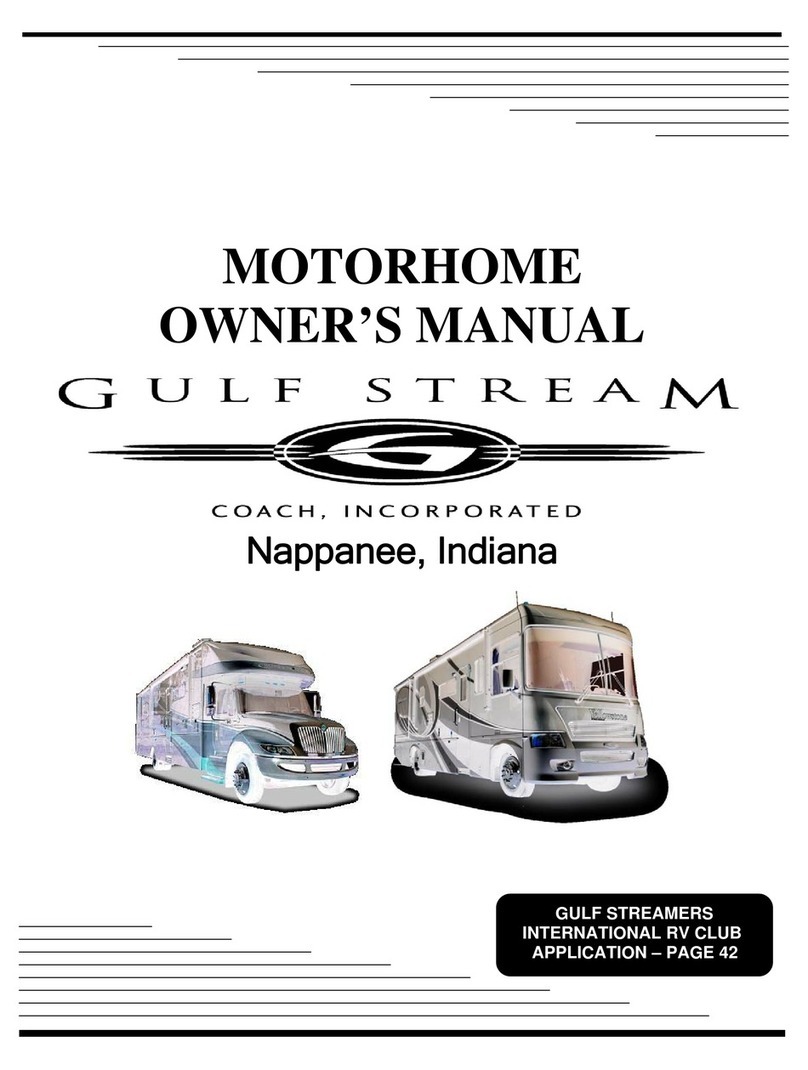
Gulfstream
Gulfstream Nappanee owner's manual

Bluebird
Bluebird 1994 Wanderlodge Wide Body owner's manual
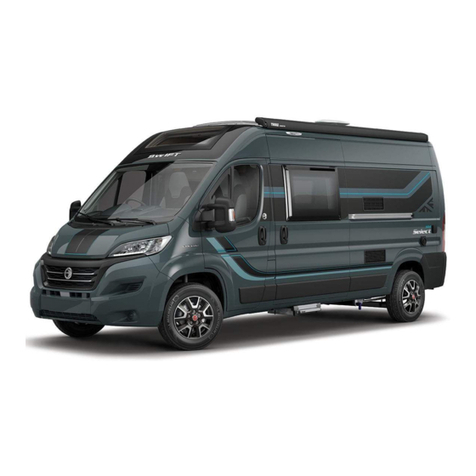
Swift Group
Swift Group Select 122 Owner's handbook

Winnebago
Winnebago Vista owner's manual

Airstream
Airstream 2005 International Trailer owner's manual




